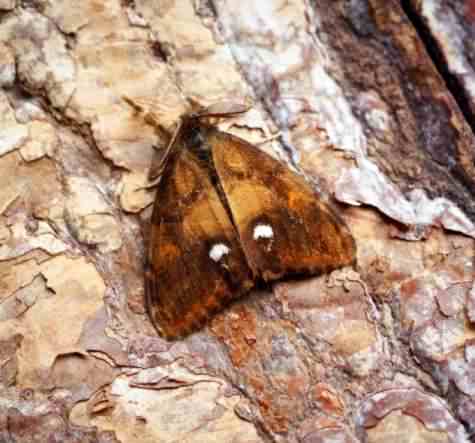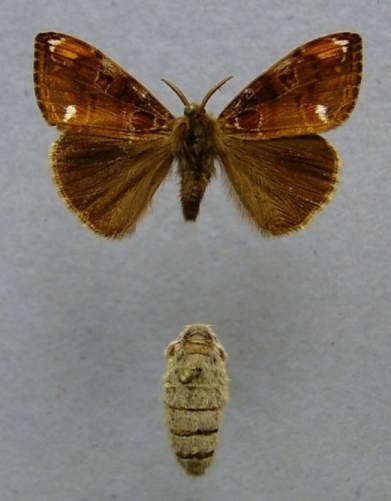
Male
Photo ©2017 Ben Sale
Click any photo for a larger image
More photos
Male
Photo ©2017 Ben Sale
Click any photo for a larger image
Vapourer Moth - Orgyia antiqua
Family - Erebidae
Also known as - Rusty Tussock
This moth is native to the southern UK and Europe but does occur in the Palaearctic and Nearcticecozone. Listed as a common resident in the UK it is not listed in the IUCN (2007) Red List. The male is diurnal and may be found in shrub–based habitats, including gardens, parks, open woodland, fens, hedgerows, heaths and moors, flying from May to October in one long, or sometimes two shorter broods. As can be seen from the images it is a species that exhibits an extreme sexual dimorphism between the adult male and the female moths.
The male is easily recognisable, the wings and body are a brownish colour with a dark brown band to the postdiscal and marginal wing areas, an orange discal patch whilst the remainder of the wing is a blotched orange and brown. There is a well defined white comma shaped discal spot. Wingspan is 20–30mm (0.8–1.2in) and the comb–like Antennae are strongly feathered.
The female is basically a yellowy beige to grey brown hairy blob rather like a small immature but bulbous caterpillar. Following emergence from her cocoon, to which she remains attached, she gives off pheromones that males can track using their comb–like antennae so they can begin mating. Although she has vestigial wings she is flightless and will not move from her position during her brief adult life.
The very hairy caterpillars of the Vapourer moth are quite spectacular, each blueish grey body segment has several red tubercles from which sprout a dozen or so white hairs, a further four body segments at the rear have large dense tufts of pale orange bristles, all combining to make the caterpillar look like a rather hairy toothbrush. Brownish coloured eggs are laid on the females vacated cocoon and they overwinter at the egg stage.
The caterpillars feed on a wide range of deciduous trees and shrubs including Birches, Hawthorns, Lime, Blackthorn, Oaks, Willows, Bilberry – Vaccinium myrtillus, Cotoneaster and Pyracantha. It has also been recorded damaging Sitka Spruce and other conifers when available.
| ← — Vapourer Moth — → | ← — Scarce Vapourer — → | |||
 Male & Female Photo ©2005 Patrick Clement |
 Caterpillar Photo ©2005 Georg Slickers |
 Caterpillar Photo ©2008 Ivengo |
 Male & Female Photo ©2009 Dumi | |
| Click any photo for a larger image | ||||
The Vapourer moth can be confused with the Scarce Vapourer (above right), which is a very similar moth in most respects including the extreme sexual dimorphism. The Scarce Vapourer males colouring is more uniform and does not have the orange discal patch, and the discal spot is less well defined. The four tufts of dense hair on the caterpillar appear more centralised in the body length and more an orange colour, whereas for the Vapourer moth they are nearer the tail and white. Hairs in the tubercles along the spine for the Scarce Vapourer are yellow not white. The Scarce Vapourer is a very rare species restricted to a few sites in northern England and Scotland. Spots at the base of the tubercles are red in the Vapourer and orange for the Scarce Vapourer.
Site design ©1999– Brickfields Country Park - Privacy -